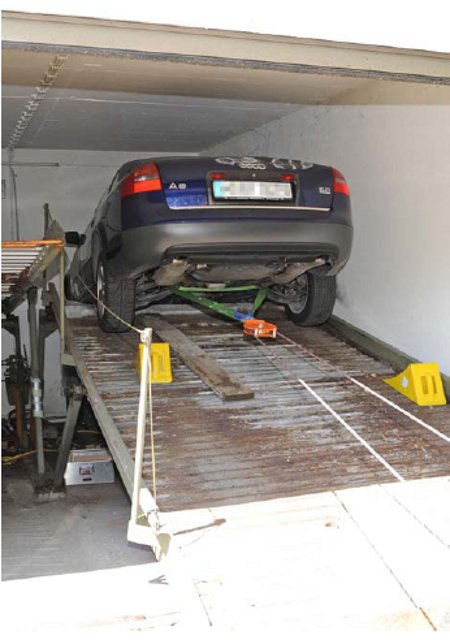Car Recovery – Always Think One Step Ahead
 Picture: Munich Fire Department
Picture: Munich Fire Department
I came across an interesting situation while reading the incident reports of the Professional Fire Brigade Munich. Imagine you are the local fire chief…
… of Bumfuck, Bavaria. After a nice little morning pint, your pager goes off and informs you all of a little technical accident assistance needed in Dulltown. The Dulltown Volunteer Fire Department has also been alerted with its engine.
Because Bumfuck isn’t exactly the smallest town ever, you guys need about 20 minutes to arrive at the scene of the incident. Once you have arrived, you check in with the lieutenant of Dulltown, who has already pretty much gotten everything ready. This is what’s going on:
Initial situation
The approx. 79-year-old driver and his car somehow ended up between the parking platform and the wall of the duplex garage; how it happened is still unknown. The team members have already attached a grip hoist to the damaged car and are waiting for the o.k. to start with the recovery.
This is what it looks like:

Initial situation after arriving at the scene of the incident (Picture: Munich Fire Department, altered by feuerwehrleben.de)
Your job
The lieutenant asks you, the fire chief, whether you could pull the car out with the grip hoist. So take a look at the situation described above and think about what your next plan of action would be.
Only
keep
reading
if
you‘ve
come up
with
a
solution
![]()
Possible solution
First, one should consider the standard possible dangers:
- Breathing poisons: no
- Fear response: no
- Spread: yes, fuel, oil, etc.
- Atomic radiation: no
- Chemical substances: yes, fuel, oil, etc.
- Sickness: no
- Explosion: no
- Electricity: yes/no, disconnect car battery
- Structural collapse: yes, the duplex hoisting platform could cave in; the car could roll down the slant while it’s being pulled out
The last point is the most important one I’m trying to make: If you are going to change the positioning of a car, you should always consider what the object will do in the new position and, especially, where it’s going to move to.
This is why the original picture from the Professional Fire Brigade Munich doesn’t look like the one above, but rather like this:

This is how the Munich Fire Department solved the problem. (Picture: Munich Fire Department)
You can clearly make out the yellow clamping blocks, which were laid down by the Munich team to prevent the car from rolling down.
As an experienced fire chief, you, of course, made the Dulltown team aware of this additional safety measure and successfully pulled the car out of the unfortunate position.
I guess one more question would be why the clamping blocks were placed in an offset manner? I think it might be because this makes the braking action even more efficient. What do you guys think?
Tags: grip hoist, incident, munich
